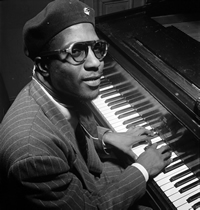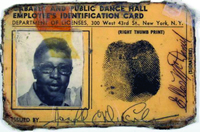Allegro
A brief history of New York City’s Cabaret Laws
Labor History Month
Volume 116, No. 5May, 2016

From 1927 to 1967, musicians needed a “cabaret card” to perform in New York City. These cards could be taken away at the whim of the police. Local 802 member Thelonious Monk had his card revoked three times.
New York’s cabaret laws had been on the books since 1927, born in the wanton days of the jazz age, but only really hit their damaging stride in 1943, when all musicians working in New York City were made to carry a “cabaret card” to perform in its nightclubs and bars, a license which could be, and was, snatched away or denied renewal at the slightest offense, effectively blacklisting an artist from performing in the city for years at authority’s whim. New York’s cabaret card provisions were intended to be a force in the fight against the city’s criminal element, but the licensing requirement had the effect of undermining New York’s capacity as an incubator of art for decades.
Take for instance jazz great Thelonious Sphere Monk, who three times had his cabaret card revoked through the 1940s and 50s, coming up for air all too briefly for his famous engagement with John Coltrane at the Five Spot in 1957. Thelonious saw some successes emerge during his intermittent ban, but only in spite of the unduly harsh law. “Brilliant Corners,” his classic recording from the period and one of the greatest jazz recordings ever made, one that was recently added to the Library of Congress’ esteemed National Recording Registry, was cobbled together with an under-prepared makeshift band at a time when he could not legally perform in the city. Only in the 60s did he establish a stable band and win commercial success, when he was arguably past his prime. Charlie Parker, Billie Holiday, and many other famous performers seeking a narcotic muse fell victim to the cabaret card law, but consider too, how many talents were rendered obscure or snuffed out entirely by the law’s Draconian demands. Frank Sinatra, in an act of kind solidarity with his fellow artists (and perhaps some underworld friends), famously refused to perform in New York during at least part of the law’s damaging run.

Bo Diddley’s original cabaret card was recently sold at an auction for $2,500.
And what about The Ramones, the band Television, or The Talking Heads? It is debatable whether any of these groups would have been able to hold on to such licenses for long in the dingy, dangerous and paranoid New York of the 70s, particularly in the seedy confines of the Bowery. No CBGBs, no scene. No scene, no punk. No punk, no Pistols, no Clash (no future indeed). And it’s tough to say what would have happened to hip hop, which largely found its gestation in more informal atmospheres, but its development as an artform would have likely suffered as well, especially given the cabaret law’s moralizing aims.
It is thankful then that these laws did not remain in the books (though others lingered on). And that thanks is due to NYC Major John Lindsay, Commissioner of Licenses Joel Tyler, and others, for striking down a foolish decades-old law on Sept. 25, 1967.
Excerpted and reprinted with permission from the WNYC archives. Original story at http://bit.ly/1M9Xkv6, where you can also hear the audio of Commissioner Tyler announcing the end of the law. It was not just the mayor and the commissioner who deserve credit for dissolving the cabaret laws. In 1960, a Citizens’ Emergency Committee – which included Harold L. Humes, Norman Mailer, Local 802 member David Amram, Norman Podhoretz and George Plimpton – successfully confronted Police Commissioner Stephen Kennedy at a public hearing about the card system.
